The Last Shall Be First: The Women of Holy Week
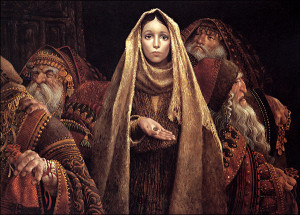
The past few years I have been on a mission to write, preach, and teach the women of Holy Week back into our Holy Week liturgies, practices, and Scriptures. In this post we’ll learn about the first two women we meet during Holy Week in Matthew and Mark.
When I decided I wanted to write a blog post on the women of Holy Week, I started flipping through the Gospel accounts, and I was surprised to find the first woman mentioned in Holy Week was the widow who gave her last two pennies as an offering in the Temple. For some reason I never connected her story with Holy Week. And for good reason: before her story is a list of controversies and debates Jesus was having with the religious leaders in the Temple. After her story Jesus described the Temple being destroyed, and what would happen before his second coming. Big stories with lots of drama are on either side of this humble, generous widow. First let’s look at her story:
Jesus sat down across from the treasury and watched the crowd throw money into the treasury. Many who were rich threw in large amounts. A widow who was poor came and threw in two small copper coins, which are worth a penny. He called his disciples and said, “Believe me when I say that this widow who was poor gave more than all those who are contributing to the treasury, because they all gave out of their abundance, but she, poor as she is, gave everything she had – all she had to live on” (Mark 12:41-44, New Testament: Divine Feminine Version [DFV]).
This happened right after Jesus finished criticizing religious leaders who “devour widows’ houses and show off with long prayers” (v. 40). Normally this woman is praised in stewardship campaigns as a person who gives unselfishly to God, trusting God will provide. But that interpretation does this woman a great disservice.
Elizabeth Struthers Malbon notes: “The poor widow is unlike the self-centered scribes and instead like Jesus–one who gives all. The last words of her story could well be translated ‘but she from her need cast in all of whatever she had, her whole life.’ Perhaps we are to assume that the poor widow has been victimized by the greedy scribes and by the authority of traditional religious teaching. But in this again she is like Jesus, who teaches with ‘authority, and not as the scribes’ (1:22), yet is victimized by those who hold authority in the temple and in the broader religious tradition” (Women in Scripture, 432).
Jesus’ praise of this woman who lived the life he called his disciples to live is the last thing Jesus said before he left the Temple for the last time. In contrast to the religious leaders who went after fame, wealth, and a good reputation at the cost of the poor and destitute (like this widow), she is shown to be humble, generous, and like Christ. Her offering of everything she had prefigured Jesus’ own offering of his life on the cross. Instead of being praised for stewardship campaigns this woman should be praised for pointing the way to Christ and for living the same kind of life, that Jesus himself lived: an all-encompassing sacrifice to God.
After Jesus praised this woman and left the Temple, he described the future destruction of Jerusalem and the Temple, and what would happen when he returned to institute fully the reign of God. In chapter 14 we discover this end of times discourse is nestled between two stories of women and their Christlike generosity. In Mark 14:1-11 we meet the woman who anointed Jesus as king and prepared him for his death and burial the day before he celebrated the Last Supper and would be betrayed by Judas (for her story see my sermon, Anointing the King). Again a woman’s story is surrounded by religious leaders who are now seeking a way to arrest and kill Jesus without having an uprising on their hands.
Once again Mark contrasts the thoughts and actions of corrupt religious men with the Christlike actions of a woman:
When he was in Bethany, reclining at the table in the house of Simon who had leprosy, a woman approached him with an alabaster jar of very expensive ointment made of pure nard. She broke the jar and poured it over his head. But some got angry. “Why has this ointment been wasted?” they said to one another. “This ointment could have been sold for more than three hundred denarii and given to those who are poor.” They scolded her.
But Jesus said, “Leave her alone! Why are you bugging her? She has done a good deed for me. You will always have people who are poor with you, and you can help them whenever you want to; but you won’t always have me. She did what she could. She poured this ointment on my body to prepare me for burial. Believe me when I say that wherever the good news is proclaimed in the whole world, what this woman has done will be talked about in memory of her” (Mark 14:3-9, DFV).
This the first scene in Mark’s passion narrative. This woman who acted as a prophet (or priest) and anointed Jesus as king began Jesus’ journey to the cross. Like the widow we see another selfless act of generosity. Whereas the widow’s offering was ignored by all but Jesus, this woman’s offering was criticized as wasteful by all but Jesus. Jesus rebuked the critics and praised the woman for preparing him for his burial. Jesus knew his road to being king went through the cross. He promised that wherever the Gospel was proclaimed this woman would be remembered, and she has been. After this woman’s extravagant gift Judas decided to betray Jesus and went to the religious authorities who paid him 30 pieces of silver to lead them to Jesus when crowds wouldn’t be around to protest his arrest.
In comparing these two women Malbon notes: “One woman gives what little she has, two copper coins; the other gives a great deal, ointment of pure nard worth more than three hundred denarii; but each gift is symbolically or metaphorically priceless. The irony that the poor widow’s gift occurs in the doomed temple is matched by the irony that the anointing of Jesus Christ, Jesus Messiah, Jesus the anointed one, takes place not in the temple but in a leper’s house (14:3), and not at the hands of the high priest but at the hands of an unnamed woman” (Women in Scripture, 433).
The widow and the prophet: these two women close Jesus’ public ministry and begin his journey to the cross. The both foreshadow Jesus’ coming death, and they both live the life of sacrificial faith that Jesus himself entered through his arrest, crucifixion, and death. They won’t be the last women we meet this Holy Week. In fact in Matthew and Mark, the entire passion is enclosed within stories of women: The prophet who anointed Jesus opens the passion, and the women who stood vigil at the tomb close the narrative. As Jesus lived through betrayal, arrest, denial, the agony of the cross, and death he was embraced in the arms of the women who followed him, obeyed him, and did not forsake him.
How will we follow these women’s Christlike examples through Holy Week and through the rest of the year? What do the widow and the prophet have to teach us about living Christlike lives?
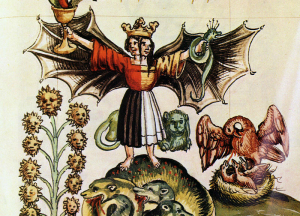 On New Year’s Eve I joined one of my best friends, Bishop Lainie Petersen, on the
On New Year’s Eve I joined one of my best friends, Bishop Lainie Petersen, on the 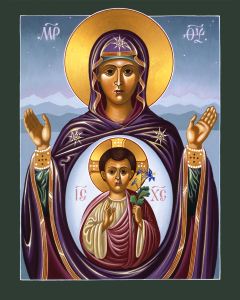 Wisdom Has Built for Herself a House
Wisdom Has Built for Herself a House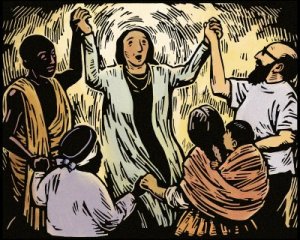 My soul praises the Lady,
My soul praises the Lady,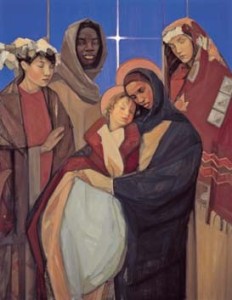

 Today is the feast day of one of my personal patron saints: St. Hildgard of Bingen. I first met Hildegard in college when I discovered her and a host of other medieval women theologians who were ignored in academia because they were nuns and mystics and not teachers and theologians like the big-named men were. Matthew Fox correctly observed that if Hildegard had been a man she would be famous and everyone would know who she was just as everyone knows who Thomas Aquinas is. I had been hoping to write my own reflection on Hildegard, but between The Novel and classwork, that is not going to happen. But that is OK because the Presiding Bishop of The Episcopal Church (my presiding bishop) Katharine Jefferts Schori has written an incredible sermon on Hildegard:
Today is the feast day of one of my personal patron saints: St. Hildgard of Bingen. I first met Hildegard in college when I discovered her and a host of other medieval women theologians who were ignored in academia because they were nuns and mystics and not teachers and theologians like the big-named men were. Matthew Fox correctly observed that if Hildegard had been a man she would be famous and everyone would know who she was just as everyone knows who Thomas Aquinas is. I had been hoping to write my own reflection on Hildegard, but between The Novel and classwork, that is not going to happen. But that is OK because the Presiding Bishop of The Episcopal Church (my presiding bishop) Katharine Jefferts Schori has written an incredible sermon on Hildegard: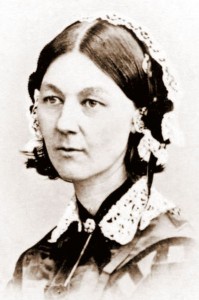
 I hadn’t thought about Florence for years then I picked up Edith Deen’s
I hadn’t thought about Florence for years then I picked up Edith Deen’s